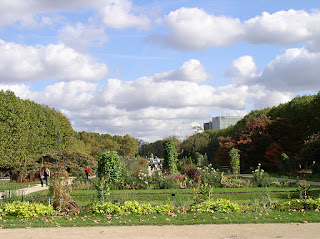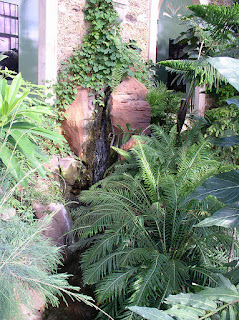The Jardin des Plantes is the main botanical garden in France. It covers almost sixty acres. Floral beds make up the approach to the collection of buildings that form the National Museum of Natural History. It is made up of the Grand Gallery of Evolution, the Mineralogy Museum, the Paleontology Museum and the Entomology Museum. In addition to the gardens, there is also a small zoo, founded in 1795 by Bernardin de Saint-Pierre from animals of the royal menagerie at Versailles.
At the main entrance to the Jardin des Plantes is a large bronze statue of Jean-Baptiste de Monet de Lamarck. On it is written, “To the Founder of the Doctrine of Evolution.” Lamarck first expressed his theory of evolution in 1809, but he presented no experimental evidence or observation, and his theory fell out of scientific favor. In The Origin of Species in 1859, Charles Darwin clearly and logically presented the idea that natural selection is the mechanism of evolution. Today this theory is the unifying one for all biology.
Statue of Lamarck at entrance to Le Jardin des Plantes
Flower beds near the entrance
Cluster of flowers near the entrance
“The Bearcub Hunter”
I’m not exactly sure what this sculpture is doing in the Jardin des Plantes, but the zoo is nearby, so there is a connection of sorts. The hunter is in a “bear hug” and a fight to the death with the mother bear. He has killed her cub, and although the hunter has inflicted a mortal stab wound on the mother bear, he is also near death himself. One look at the little bear cub, and the mother bear’s revenge seems completely justified.
The hunter and mother bear
The bear cub
The mother bear with stab wound
“Denicheur d’oursons”
Now I have to confess. This place is overwhelmingly large, and I could never have taken in the museums, the zoo, the glasshouses and the grounds, including the demonstration gardens and the Alpine Garden in one day. I ended up going through the glasshouses and Alpine Garden because I’m more interested in the flora than in the fauna. But I fully intend to come back one day and visit the museums and the zoo.
A garden bed on the way from the entrance to the Grand Gallery of Evolution
A bed of brilliant dahlias
A flower bed to one side of the center path
A continuation of the flower bed
A bed of golden flowers
"Mutant"
An art installation of FIAC (International Contemporary Art Fair) from October 20-23 in Paris
FIAC placard with the artist’s name
The main location for the Art Fair is in the Grand Palais; however, certain works of art are placed “hors les murs,” outside of the walls, or outdoors. I’ve seen them here and in the Tuileries.
A view of the gardens toward the entrance
Statue of Georges-Louis Leclerc, the Comte du Buffon
The Comte du Buffon (1707-1788) was a French naturalist and published author of 36 volumes of Histoire Naturelle, in which he set out to organize all that was then known about the natural world. He was the Director at the Jardins du Roi, now called le Jardin des Plantes, for 50 years, from 1739 to 1788. The garden “blossomed” under his direction, and he extended it to the banks of the Seine and created the great avenue of trees.
Getting the flower beds ready for planting with a view of the Grand Gallery of Evolution
The Grand Gallery of Evolution
A wheelbarrow full of plantings
Preparing a center bed for planting
Newly planted rows
Plan of the Jardin des Plantes
The Glasshouses, after more than five years of renovation, have reopened to the public. The Tropical Rainforest Glasshouse, built in 1936, is in the Art Deco style and contains an exclusively tropical ecosystem. Behind it are the New Caledonia and the Plant History Glasshouses, the oldest glasshouses in the world of such large proportions. Built in 1834, they are true prototypes for the design of modern greenhouses.
The Art Deco-inspired Tropical Rainforest Glasshouse
Tropical Forests: Green Cathedrals
Tropical Forest vegetation
"When I go into the glass houses and I see the strange plants of exotic lands, it seems to me that I enter into a dream." (Henri Rousseau, 1844-1910) At the Jardin des Plantes, Rousseau had a secret arrangement with one of the gardeners who let him spend hours painting the greenery. Instead of making the plants their actual size, he would make them as big as trees. The artist’s rendition made the picture resemble a fantasy world; he was disparaged by critics and never reached conventional acceptance during his lifetime. He is now known and respected as a “Primitive” artist.
Nymph
This forest sprite is a FIAC art installation, which came as quite a surprise amidst all the natural jungle-like vegetation. The name of the artwork is “Platee,” by Alain Sechas. I think it means, “Quite a dish.”
Three levels of man-made grottoes in the Rainforest
A path leading to the grottoes
Steps leading up to a grotto
Stepping stones within the grotto
A closer view of the grottoes
A tree as seen from the highest grotto
The New Caledonia Glasshouse is a showcase for the wide-ranging flora to be found in the French territory “at the world’s end,” considered to be an important area for global biodiversity due to the many exceptional and unique species that it harbors. It is an archipelago of approximately 7,000 square miles in area and located between Fiji and Australia in the South Pacific.
The New Caledonia glasshouse
Totems and artwork of indigenous Kanak people from New Caledonia
New Caledonia flora
New Caledonia flora
The Glasshouse of Plant History tells the story of ‘green colonization’ that started 420 million years ago when small, short, half-moss, half-seaweed plants moved from the oceans to start progressively covering the continents. The history of man, which started 200,000 years ago, seems incredibly short compared to that of plants.
Plant History
Plant History
Plant History
Plant History
Plant History
Plant History
Plant History
The Jardin des Plantes maintains a botanical school, which trains botanists, constructs demonstration gardens, and exchanges seeds to maintain biotic div ersity. About 4,500 plants are arranged by family on a two-and-a-half acre plot. Seven-and-one-half acres are devoted to horticultural displays of decorative plants. An Alpine garden has 3,000 species with world-wide representation.
Signs for the Botanical School and Entry to the Alpine Garden
Botanical School garden with plants labeled
Entrance to the Alpine Garden
The Alpine garden is beautifully laid out with changes in elevation. It has more than 3,000 species from various mountainous regions around the world.
Alpine Garden
Alpine Garden
Alpine Garden
Alpine Garden
Pool in the Alpine Garden
Bee Hotel
FIAC art: “Le Theoreme des dictateurs” by Vincent Mauger
It is over 15 feet in diameter and has very menacing-looking points. The best I can make of it is, “The Dictators’ Theorem.” Maybe it illustrates graphically how a dictator forcibly reaches agreement among members in a group.

Sculpture of Bernadin de Saint Pierre (1737-1814)
Talking Shoe Tree
Artist Malachi Farrell created the art installation of bunches of talking shoes that now hang from a Cedar of Lebanon tree in the Jardin des Plantes. The work is called “Strange Fruits“ and is on display as part of Paris’ International Contemporary Art Fair (FIAC – Foire Internationale d’Art Contemporain).The shoes carry on a conversation in the form of a parody of the Beatle’s song “She Loves You” by Peter Sellers in Dr Strangelove.
Shoe Tree

Shoe Tree
It is over 15 feet in diameter and has very menacing-looking points. The best I can make of it is, “The Dictators’ Theorem.” Maybe it illustrates graphically how a dictator forcibly reaches agreement among members in a group.

Sculpture of Bernadin de Saint Pierre (1737-1814)
He was a French writer and botanist, and he is considered to be the founder of the zoo. He was committed to the principles of keeping exotic animals in their natural environment, having regard to their needs, placing them under scientific supervision, and allowing public access in the interest of public education. While the menagerie at first was just provisional, it grew in the first three decades of the 19th century to be the largest exotic animal collection in Europe.
The origins of the hanging shoe phenomenon remain obscure. Like any social and cultural movement, no one can be exactly sure where it begins and why, but there have been sightings of shoe trees in England and the US, and no one there seems to know anything about them, either. This is the strangest thing EVER to come upon if you have never before heard of shoe trees, and I was completely unaware of this phenomenon in our country or in any other. But once you know about it, it's kind of a cool thing, and I'd be happy to contribute to one, just for the fun of it.
Artist Malachi Farrell created the art installation of bunches of talking shoes that now hang from a Cedar of Lebanon tree in the Jardin des Plantes. The work is called “Strange Fruits“ and is on display as part of Paris’ International Contemporary Art Fair (FIAC – Foire Internationale d’Art Contemporain).The shoes carry on a conversation in the form of a parody of the Beatle’s song “She Loves You” by Peter Sellers in Dr Strangelove.

Shoe Tree
If you want to see a video and hear the shoes talking, do a google search: strange fruits jardin des plantes




























































No comments:
Post a Comment